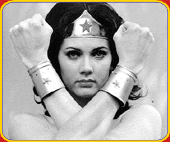  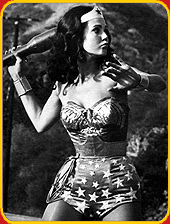 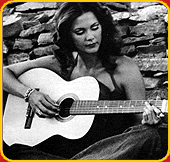 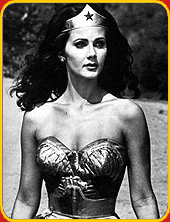 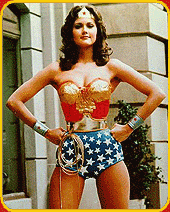 |
 Even as the Fanfare typographer was laying down copy for the
preceding article, a miracle of sorts was in the works.
Even as the Fanfare typographer was laying down copy for the
preceding article, a miracle of sorts was in the works. |
 |
|
It
started, in a way, back in 1967. That's when producer William Dozier
put Stanley Ralph Ross, one of his better Batman writers, to work on a
half-hour Wonder Woman comedy. The resultant pilot script never got
before a camera, but years later, when Warners had their own Wonder
Woman project in mind, they called Ross in. |
 |
|
He
told them how he wanted to do it: No camp, no ridiculing the character
as Batman had. What Ross proposed was, as he puts it, "somewhere
between adventure, comedy and tongue-in-cheek" and set firmly and
irrevocably in the midst of World War II. That wasn't what Warner had
in mind, it seems. Ross stashed his notes in a filing cabinet and
returned to a heavy load of other TV commitments. Warners went their
own route and produced Wonder Woman their way, resulting in
high ratings and a veritable Meleagris gallova (i.e., Turkey)
of a show. So they went back to Square One -back to the drawing board,
as it were- back to Stanley Ralph Ross. |
 |
|
Ross
brought forth his notes and pointed out that what people wanted was
the real Wonder Woman, not some cheapjack facsimile. Ross took a copy
of the Gloria Steinem/Ms. magazine Wonder Woman book (Holt, Rinehart
and Winston, 1972) and used the original Wonder Woman origin story by
Charles Moulton as a basis. He added much new material, mainly
emphasizing the Nazi menace, and came up with a gem of a first draft,
tow hours in length. Along the way, it would wind up as a 90-minute
script with not so much humor (a scene where a saleslady tries to
explain to the naive WW what a brassiere is was among the casualties)
but which was furlongs ahead of its predecessor. Particularly good was
the delicate handling of the Wonder Woman-Steve Trevor romance. Back
on the Batman show, Ross, in addition to most of the King Tut and
other "new villains" episodes, had handled the Catwoman
scripts, carefully plotting out the subtle love interest between her
and the title character. (He also designed much of Julie Newmar's
skin-tight wardrobe.) The Batman-Catwoman romance, by the way, was to
have culminated in one episode with a marriage aboard the Staten
Island Ferry - but then Eartha Kitt inherited the role from Newmar and
all romantic entanglements vanished. Television was not ready for
Batman in a mixed marriage. |
 |
|
But
television was ready for "The ORIGINAL Wonder Woman." The
comely Lynda Carter, a former Miss USA, played the Amazon Princess,
abetted by a supporting cast that included Cloris Leachman as Queen
Hippolyte, Lyle Waggoner as Steve Trevor, plus Red Buttons, Kenneth
Mars, Henry Gibson, Fannie Flagg and Stella Stevens. What finally
showed up on ABC one Friday night was a superb rendition of the
character - proof positive that a comic book can be transferred to the
screen and maintain not only the mood of the source material but also
the integrity of the character. |
 |
|
And
ABC was ready. Buoyed by its bionic successes, the network was willing
to go with the Amazon Princess, though not as a series. Rather,
programming tsar Fred Silverman ordered up a batch of Wonder Woman
specials which he could situate at will in and about his schedule, the
better to neutralize competing networks. Long the "third
network" (and, at times, just barely that), ABC was already
moving into the lead, thanks to bionics and Fonzie. Wonder Woman
proved to be Silverman's queen in the chess game of network
television. Moved into one time slot, she clobbered a Bob Hope
special; in another, a competing network movie. At this writing, the
series remains a programming nomad - but it is a series and its star
is fast becoming a star. |
 |
|
Lynda
Carter was naught but a former beauty queen when she first walked onto
the Burbank Studios/ Warner Brothers lot. She had made one appearance
on the short-lived Nakia TV series and another in an unsold pilot
called Shamus. Other than that, what she had to her credit was the
usual ex-Miss USA shtick: personal appearances, ceremonial promotions
and a USO tour. And she was but one of countless gorgeous young ladies
who journeyed to Burbank, seeking the lead role in the film of Irving
Wallace's novel, The Fan Club. Producer Larry Gordon made much
hubbub in the industry over his search for the actress who might play
Sharon Fields, the movie sex symbol who is kidnapped and ravaged by
some of her adoring public. Lynda Carter proved not to be that
actress. Neither did the rest of the countless gorgeous young ladies.
At the moment, the oft-postponed film looks like it will join the even
more countless number of unproduced movies, though there are rumors
that Barbi Benton is being considered anew. Whatever the disposition,
Ms. Carter didn't get the role. |
 |
|
Not
that Larry Gordon wasn't impressed with her, however. He liked her
and, more importantly, he told Douglas Cramer about her. Cramer, you
see, was producing this show called Wonder Woman and that's how it
happened. Soon, she was pulling down six grand a week (twice co-star
Lyle Waggoner's stipend), plus making countless TV guest appearances
and, thus far, two movies. With Lynda's television success as Wonder
Woman leading the way to a budding film career, steps were taken to
avoid the specter of typecasting (as had happened to George Reeves
following his long-running tenure as TV's Superman) by contracting for
her a wholly different kind of role in her first feature motion
picture, Bobbie Joe and the Outlaw. |
 |
|
Hang
in there now, because this is going to take us out and back via the
North Forty... |
 |
|
Bobbie
Joe, spelled that way and released by American International in
1976, was yet another entry in the recent cycle of movies dealing with
the now familiar Bonnie and Clyde theme and its mutations. The basic
situation is the same in every film. A footloose girl in her teens or
twenties hitches up with an itinerant guy of about the same age, and
together, discovering a sense of adventurous team strength they lacked
singly, they embark on an unabated crime spree while letting the devil
take the hindmost. In the main variation the protagonists are cast as
ill-fated, restless innocents brought together by chance. Having
nothing better to do they hit the road, traveling rural byways leading
to small town stops and making the disastrous mistake of crossing
county lines. By a luckless turn of events that puts them on the wrong
side of the law, they soon
find themselves pursued by and ever-tightening police dragnet, depicted
as manned through and through by tank-town rednecks. With itchy trigger
fingers at the ready, they catch the fugitives and wipe them out -
provided the couple hasn't beaten them to it by destroying themselves in
a car crash. |
 |
|
The
spectacular success of Bonnie and Clyde, starring Faye Dunaway
and Warren Beauty, started the trend in 1967. It resulted in a
succession of movies that worked assorted improvisations on the idea of
a youthful pair of criminals or social outcasts against the hopeless
odds of a system presented to us as obliged only to do them in: Thieves
Likes Us (Keith Carradine and Shelley Duvall), Buster and Billie (Jan
Michael Vincent and |
| Joan
Goodfellow), Badlands (Martin Sheen and Sissy Spacek), Return
To Macon County (Don Johnson and Robin Mattson), Dirty Mary and Crazy Larry (Susan
George and Peter Fonda), The Sugarland Express (Michael Sacks
and Goldie Hawn), Aloha,
Bobby and Rose (Paul Le Mat and Dianne Hull), among others. A new
one seemed to come out every few months like clockwork. |
 |
|
The
cycle, threatening to saturate theaters during 1970-75, had its own
sucession of forerunners produced at less predictable intervals. In 1958
Dorothy Provine and Jack Hogan were the principals in The Bonnie
Parker Story, a low budget exploitation drama directed by former
mainstay of 1940s Republic serials, William Witney. The Bonnie and Clyde
theme appeared still earlier in Gun Crazy (John Dahl and Peggy
Cummins, 1950) and They Live By Night (Farley Granger and Cathy
O'Donnell, 1948), both appropriately framed in the grim, fatalistic
postwar styler now referred to as film noir. |
 |
|
Noir
elements in Bonnie and Clyde and most of its offspring are
minimal at best. Noir elements in writer-producer-director Mark Lester's
Bobbie Joe and the Outlaw are non-existent. His previous effort
was Truckstop Women, a 1974 American International release
featuring Claudia Jennings, the 1969 Playboy Playmate of the Year. Truckstop
wasn't quite the contemporary gem it was cracked up to be, with an
energetic wimlib-inspired storyline fizzling out in a weakly staged
ending, but it did show considerable promise if Lester continued to
inject novel ideas into the old, honorable formulas. Bobbie Joe
had a bigger budget and, with Lynda Carter and Marjoe Gortner,
marginally bigger name actors. Expectations for a standout movie,
however, went unfulfilled. |
 |
|
Bobbie
Joe and the Outlaw was not precisely an auspicious screen debut for
Lynda. There is no great shortage of
guy-and-girl-on-the-lam-from-the-law films and this one has all the
imitative accouterments: Redneck Southern sheriffs, car demolition,
blood (though not a lot), sex (ditto), country-styler music (including
one song performed by Lynda) and extremely dumb plot points. Tricked
into being an accomplice to murder, the Outlaw (Gortner) must get out of
town with his woman, Bobbie Joe (Carter). At this point, the minions of
the law have absolutely no leads on the murder but they have a roadlock.
For no visible reason, other than that it had been an entire reel since
the last car chase, Gortner runs their roadlock, thereby allowing the
Keystone rejects to get his license number and description. Forced by an
unreasoning law to become fugitives, the title characters decide to do
it up right. Now, pay attention to this because it's incredible. They
want to get reputations as hot-shot bank robbers so they decide to pull
a daring, daylight Savings and Loan heist. But they have only a few
machine guns in their arsenal so, in order to get the proper weaponry,
they stage a commando-style assault on a gun shop. They kill most of the
gun shop empolyees and make off with enough pistols to pull their
daring, daylight bank job and become famous. Machine guns and murder so
they can get pistols to rob a bank and be famous. Figure that one out.
Also, figure out why the film got decent reviews and high box office
grosses. Could it have had anything to do with the fact that its release
in most cities was timed to coincide with a Wonder Woman TV special?
Maybe it had something to do with those ads that had Lynda Carter's name
in REAL BIG TYPE. Or maybe a lot of folks just like dumb movies. Or all
of the above. |
 |
|
Her
second film is not yet release: Francis Ford Coppola's Vietnam war epic Apocalypse
Now, filmed partly on location in the Phillipines in the midst of
nearly impossible weather conditions when typhoon Olga hit the island of
Luzon. The film company was, to quote from a tune by the Cadets,
stranded in the jungle -helplessly watching their sets being reducted to
shambles by the relentless downpour. Telephone communications were cut
off, all bridges were down. One group of actors and technicians were
sequestered across the river, while Coppola and additional cast members,
including Lynda, were with another group at Olongapo. For three days
each gathering was totally isolated from the others ten miles away, not
knowing if their colleagues were alive. Fortunately there were no
casualties. During her two and a half weeks in the Phillippines, Lynda
spent most of the time slogging about in the mud clad in Army fatigues
and combat boots, hoping with everyone else to get production underway
again. Eventually Apocalypse Now resumed filming and she was able
to complete her scenes, after which she returned stateside to start work
on the first of eleven 60-minute Wonder Woman specials. |
 |
|
Lynda's fast-accumulating credits as a dramatic actress often overshadow
her other talents in the performing arts. She's been interested in
singing for as long as she can remember. Raised in Phoenix, Arizona, at
age 15 she started singing several nights a week at the local college
crowd's favorite after-hours hangout, the Pizza Inn. Enrolled at Arcadia
Titans High School in Scottsdale, a Phoenix suburb, she was an active
participant in choral groups and musical theatre productions. She played
the role of Rosie in a student production of Bye Bye Birdie.
After graduating from Arcadia she went on the road to perform
professionally, debuting at the Sahara in Las Vegas. She traveled the
club circuit for three years until she decided the rigors of that life
weren't for her, so she gave up touring and returned home. She cut a
demo for a recording company. While waiting in Phoenix for the outcome
of her demo session, she entered a beauty contest. In only one month's
time she was Miss Phoenix, Miss Arizona, Miss USA, and was then on her
way to London for the Miss USA, and was then on her way to London for
the Miss World Pageant. When this whirlwind of activity was over, she
headed for Hollywood to study acting. This Miss USA title proved to be
more of a hindrance than a help at first, but soon the career she looked
for started to take shape. She still studies acting, now with coach
Laura Zucker, fitting classes into an increasingly busy calendar of
occupational pursuits. |
 |
|
A
steady stream of guest appearances (Hollywood Squares, Dinah!, The
Carson Show) are integrated into Lynda's shooting schedule on Wonder
Woman. Though the show is filmed relatively fast at Burbank Studios,
it still takes a good deal of time -and exhausting time, at that. She
does most of her own stunts and, when the camera is off, puts herself
through a rigorous exercise program. Though others may have just cause
to admire her figure, Lynda Carter is ever-so-critical. The first time
she saw herself on-screen in the Wonder Woman skimpies, she was
horrified and inmediatly went on a crash jogging program to plane down
her hips. A semi-vegetarian, she is also an advocate of Pyramid Power,
reincarnation, parapsychology, psychic energy and various and sundry
higher wisdoms. Her press agent hand-out informs us that, in the past
existences, she was an Aztec Indian, and English commoner, a Pioneer and
the wife of a Pharaoh. Sure sounds like a super-heroine to me. |
 |
|
So there you
have her: Lynda Carter, latest in the line of superhero personators,
starring in one of the better comic-book-to-film transferences.
Hopefully, Wonder Woman is but the first in a new wave of many. |
Even as the Fanfare typographer was laying down copy for the preceding article, a miracle of sorts was in the works.